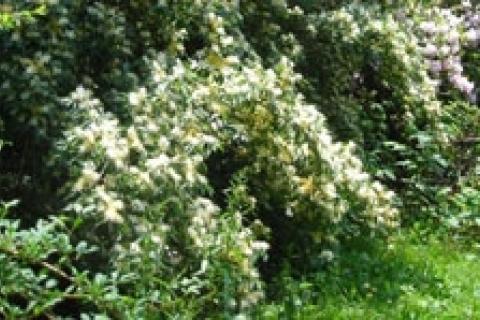
Many people believe they can't improve their deer hunting property because they don't have a barn full of expensive equipment. Nothing could be further from the truth.
 |
| Stems and leaves from low-growing bushes, like a Japanese honeysuckle, are staples for whitetails. |
You can improve both the quality and quantity of natural forage on your land or property you lease with just a few quick, easy projects.
If you have a pair of clippers, a bucket, chain saw, fertilizer, lime and a few hours to spare, you can make major steps towards enhancing the habitat on your hunting land.
In this blog we'll describe how to identify these prime foods on your property, survey where they are, record them on a map and choose the best ones to enhance with your habitat work.
In a follow-up next week, we'll delve into five quick projects you can do once you've taken these preliminary inventory and recording steps.
But first let's describe the focus of the projects: fruit trees, bushes and shrubs. Fruits from trees and stems and leaves from low-growing bushes such as raspberry, blackberry and Japanese honeysuckle are staples for whitetails throughout much of the country.
You probably have some of these growing on your property. That's good. But you can improve the quality of the protein level and nutrients they provide, "sweeten" their taste appeal, increase their abundance, and make them more readily accessible to the deer (in spots you choose, such as near a potential stand site) with a few easy steps.
How much good can you do?
A study by the Alabama Agricultural Experiment Station showed that fertilizing a stand of honeysuckle can increase its forage production two fold and raise its protein level to as high as 17 percent. A one acre patch in the study produced over one ton of forage!
And fertilizing is just one project. Day-lighting, pruning, liming and repositioning vines so deer can reach them more easily are other ways you can enhance the natural forage on your land.
Before getting started, though, you need to identify what valuable plants you have that appeal to deer. Scout the property methodically to identify prime foods that you have to work with. Look for wild apple, pear, plum, persimmon, pawpaw and crabapple trees. Pinpoint shrubs such as blackberry, raspberry, blueberry, grapes, lespedeza, Chickasaw plum, viburnum, indigo, greenbrier and Japanese honeysuckle.
Record them on a map. A topo will work, but a better bet is to draw a map on a larger scale, so you have room to record and label all the valuable fruits and edible shrubs.
Select the ones to improve based on where you want to place hunting stands and which ones are most likely to see the most deer use. That generally means those near heavy security cover.
Now that you've inventoried and mapped out your valuable bushes and fruit trees, you're ready to begin your improvement projects.
We'll delve into those next week.
- 3487 views

